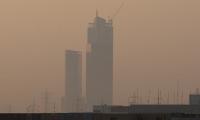The writer is the author of 'Governing the ungovernable'.
There is one single point on which there is a national consensus right from the prime minister to the opposition leaders to the public at large – the country is suffering from the serious malaise of inflationary pressures with their harmful effects on the lives of the citizens.
Inflation is generally welfare depressant and particularly inimical to the poor, the middle classes with no tangible assets, the salaried class, pensioners, widows and other fixed-income earners. The propensity to consume for all these groups is relatively high – they spend a substantial part of their incomes on essential items such as food, rent, utilities, transport and clothing and therefore they feel the pinch of inflation the most. It is therefore important to examine the underlying causes of inflation in a dispassionate manner and the remedial measures to tackle this issue in the future. Unfortunately, there is no magic wand to fix the problem in the short term and those who promise to bring down the prices immediately are not really serious. Distorted markets and weak public-sector institutions would not permit to do so, however sincere our intentions may be.
What are the underlying factors behind this unending phenomenon of rising prices that is causing widespread anxiety among the majority of the population and earning unpopularity for the government? Inflation, by definition, is excess money flowing through the economy while there is shortage of goods and services. Thus, inflation can originate from either rise in aggregate demand or supply shock or interplay between the two.
Let us first deal with global supply shocks that are exogenous – outside the control of national policymakers. The Covid-19 pandemic wrapped the advanced, emerging and developing economies within its fold and lasted for two years. The recession resulted in a slow down of economic activity and increased unemployment. To fight recession, generous fiscal stimulus was provided by the governments including unemployment benefits, cash grants. With savings in hand that couldn’t be spent earlier, the post-pandemic era witnessed a surge in demand for goods and services.
Retail sales in the first half of 2021 were 22 percent higher than a year ago. However, at the same time energy prices shot up, labour and material shortages appeared, global supply chains got disrupted due to lengthy shipping delays caused by container lines, port congestion, and backlog in inland freight movement. In the UK, drivers were not available to move trucks. Cars and electronic industries were hard hit by the shortage of semiconductor chips. Lower production at farms and processing plants spiked up food prices. Production and supply chain bottlenecks are pushing prices to unprecedentedly high levels within a short period of time. Oil prices doubled from $40 a barrel to $80 within a span of a few months. RLNG spot prices reached astronomically high levels. Coal shortages in China led to loadshedding and closure of factories. Metal prices registered the same upward trend.
The global supply shocks had repercussions for Pakistan’s economy as imports of goods and services account for more than a quarter of GDP and the country is dependent on POL products, machinery, food, industrial raw material, transport for both consumption as well as production. Despite the government reducing sales tax, levy and import duties on many essential goods and not choosing to pass through the entire burden of global spike in prices to the consumers, the impact was still quite significant. Had the whole burden been passed through, the inflation rate would have been much higher than what has been recorded. Adjusting the petroleum levy and GST downwards to the tune of Rs450 billion has severely hit government revenues but provided some partial relief to the consumers. Despite these adjustments and negative impact on fiscal balance, (the government has to increase its borrowing which would also contribute to inflationary pressures), the resulting hue and cry on price hikes of POL products is understandable due to its secondary effects on transport costs and perishable commodities prices.
In Pakistan, a complicating factor is the movement of exchange rate that has proved to be a double whammy. For example, even if the world prices of POL had doubled but the Pak rupee-dollar parity had remained unchanged and the government had lowered its share of taxes, the price adjustment would have been less painful. Thus, devaluation has been a major contributory factor in the case of Pakistan in amplifying the impulses of imported inflation arising from high global commodity prices. Countries where the exchange rate has remained relatively stable have been insulated from this amplification. Therefore, inflation rates in India and Bangladesh are lower than that in Pakistan.
The issue of exchange rate adjustment would require a separate analysis but suffice to say that the State Bank can intervene only for smoothing volatility if the market conditions become disorderly. Should it intervene to defend a particular level of exchange rate, it would deplete foreign exchange reserves quite fast, and the market sentiment would turn negative. We would then end up with the worst of both worlds – erosion of foreign exchange reserves (built with great difficulty) and a fast-depreciating currency.
On the demand side in Pakistan, the smart lockdown kept the wheels of the economy running and GDP growth in FY21 was higher than expected. Close relations with China helped in getting 100 million people vaccinated. The fiscal stimulus package of emergency cash assistance to 16 million households – almost one half of the population – monetary easing by provision of concessional financing for machinery and equipment, payment to workers and other refinancing schemes put money in the hands of a large number of consumers and investors pushing the aggregate demand upwards. Generous price support for farmers boosted the purchasing power in the rural areas (60 percent of the population) and increased remittances from workers abroad added further to this rising demand.
As the country's industrial and farm production capacity was inadequate in relation to this rising demand, the excess spilled over in the form of higher imports. It is interesting to note that the farm sector saw a peculiar phenomenon – lower volumes, higher prices and rising incomes. Wheat, sugar and cotton had to be imported in large quantities which added further pressure on the current account compared to the previous year. There are some transitory or one-off factors such as import of vaccines for Covid-19 and other related supplies that have also added to the import bill in FY 21. Current estimates of cotton arrivals also indicate that the quantum of cotton imports this year may be lower than the previous year. Demand for wheat and sugar imports may have to be reassessed after harvesting of the two crops.
Another source of inflationary pressures is the administered prices of electricity and gas. Regulators use the formula of costs incurred, revenue requirements, guaranteed rates of return and other subjective factors to determine the tariff structure. In many countries, prices are deregulated and determined through market interactions. The job of the regulator is to protect consumers and ensure that there are no collusive practices, market abuses, concentration of market share etc. Banking and telecom sector regulators in Pakistan do not determine the prices of banking products or telecom services although both sectors are dominated by the private sector.
State-owned enterprises in the energy sector are poorly governed, devoid of technical and managerial expertise, dominated by narrow vested interests. They have weak enforcement capacity, and their inefficiencies, leakages, waste and corruption are passed on to the consumers in the form of higher tariffs or subsidies from the public exchequer.
To be continued
Internationally, there have been misleading theories propounded about so-called slowing of Chinese economy
Karachi has long been Pakistan’s financial capital and a major hub for industry and trade
In the past, with every rising of the sun, much anticipation was associated with reading the newspaper
It is clear that more is at stake as US abandons its role as global leader of system based on multilateralism
I believe that those who adopt attitude of forgiveness, mercy and tolerance are role models for all of humanity
First major point of contention between Brussels and Washington is the unequal distribution of defence expenditure







